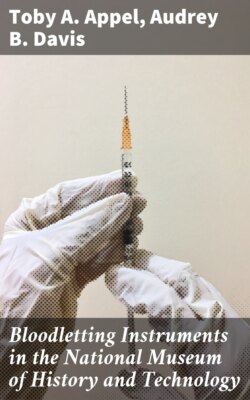Читать книгу Bloodletting Instruments in the National Museum of History and Technology - Audrey B. Davis - Страница 8
На сайте Литреса книга снята с продажи.
Sources
ОглавлениеTable of Contents
While primary sources describing the procedures and presenting theoretical arguments for and against bloodletting are plentiful, descriptions of the instruments and their manufacture are often difficult to find. Before the nineteenth century, one may find illustrations of bloodletting instruments in the major textbooks on surgery, in encyclopedias such as that of Diderot, and in compendia of surgical instruments written by surgeons. The descriptions following the drawings are often meager and give little indication of where, when, and how the instruments were produced. Until well into the nineteenth century, the tools used by barber-surgeons, surgeons, and dentists were made by blacksmiths, silversmiths, and cutlers. These craftsmen generally left little record of their work. As the demand for surgical instruments increased, specialized surgical instrument makers began to appear, and the cutler began to advertise himself as “Cutler and Surgical Instrument Maker” rather than simply “Cutler and Scissor Grinder.” A few advertising cards dating from the eighteenth century may be found, but the illustrated trade catalog is a product of the nineteenth century. Among the earliest compendia/catalogs of surgical instruments written by an instrument maker, rather than by a surgeon, was John Savigny’s A Collection of Engravings Representing the Most Modern and Approved Instruments Used in the Practice of Surgery (London, 1799). This was followed a few decades later by the brochures and catalog (1831) of the famous London instrument maker, John Weiss. By the 1840s John Weiss, Charrière of Paris, and a few other instrument makers had begun to form surgical supply companies that attempted to market instruments over a wide area. While there are a handful of company trade catalogs dating from the 1840s, 1850s, and 1860s, the great influx of such catalogs came after 1870. Trade catalogs, a major source of information on the new instruments of the nineteenth century, provide the historian with line drawings, short descriptions indicating the mechanism and the material of which the instrument was composed, prices, and patent status. For more details on nineteenth-century instruments one must turn to brochures and articles in medical journals introducing the instruments to the medical profession. These sources provide the most detailed descriptions of how the instruments were constructed, how they were used, and why they were invented. For many American instruments, the descriptions available at the U.S. Patent Office offer illustrations of the mechanism and a discussion of why the instrument was considered novel. One finds specifications for many bizarre instruments that never appear in trade catalogs and may never have been actually sold.
A final source of information is the instruments themselves. Some are engraved with the name of the manufacturer, and a few are even engraved with the date of manufacture. Some have been taken apart to study the spring mechanisms and others examined in the Conservation Analytical Laboratory of the Smithsonian Institution to determine their material content. The documentation accompanying the instruments, while sometimes in error, may serve to identify the individual artifact by name, place and date of manufacture, and to augment our knowledge of the historical setting in which these instruments were used.
